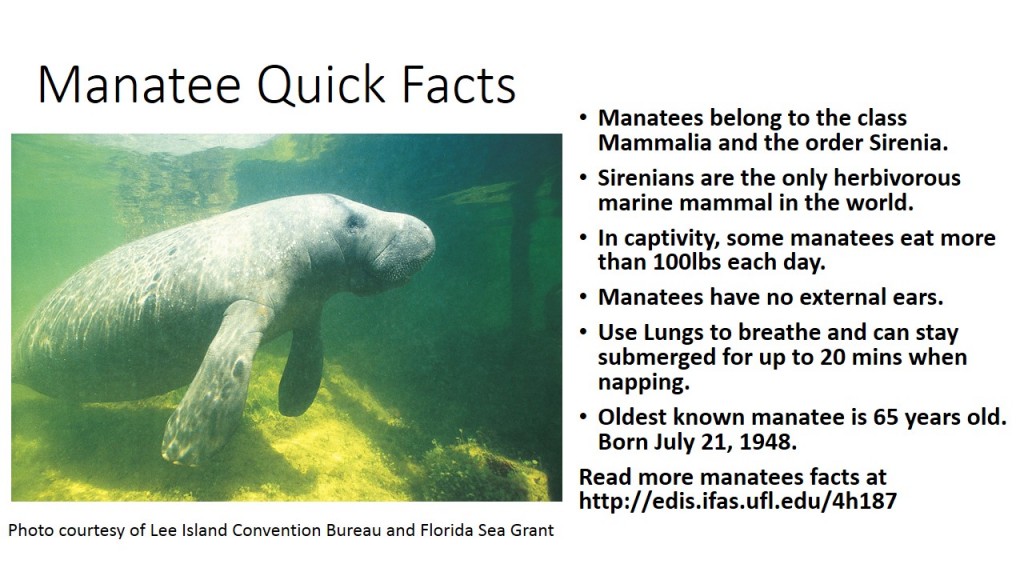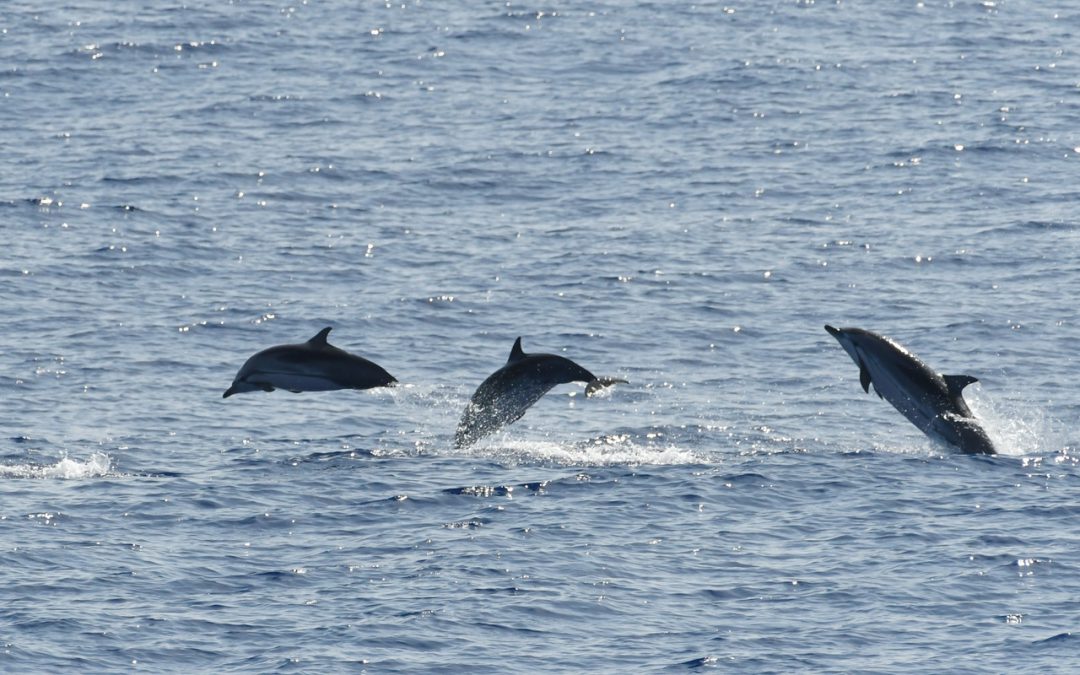
by Rick O'Connor | Mar 9, 2020
When it comes to charismatic wildlife, there are few that are more than marine mammals. Everyone loves whales and dolphins. Even today, as many years as I have been working on the water, my colleagues and myself still get excited when we see dolphins. Seeing a whale is like a life-long bucket item. Marine mammals are pretty exciting to see.
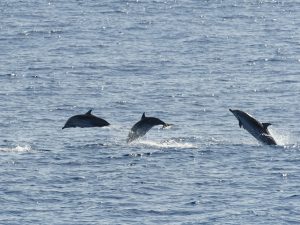
A group of small dolphin leap from the ocean.
Photo: NOAA
In the world of marine mammals there are four different groups. Of course, there are the whales and dolphins (the cetaceans), there are the seals and sea lions (pinnipeds), the manatees (sirenians), and… believe it or not… the polar bear (ursids). But we only find two of these in the Gulf of Mexico. The polar bear, of course, does not live here. I know you needed to hear that from me. Pinnipeds no longer live here. Many may be surprised that there was once the Caribbean Monk Seal. There are records of this animal in the southern Gulf, but it is now extinct. There are records of California Sea Lions in the Gulf, possible release from some aquarium program – who knows, but no one has seen any in decades and it is believed they no longer exist here. So that leaves the cetaceans and the manatee.
The most recent publication (2017) states there are 28 species of cetaceans in the Gulf of Mexico. Cetaceans are subdivided into two groups: the baleen and the toothed whales. It is believed that 27 of the 28 species in the Gulf are toothed whales. Baleen whales are the big boys, 50-100’ in length and weighing tons. Some are the largest animals that ever existed on our planet. Most prefer cooler waters. Records of species come from whaling logs of the 19th and early 20th century as well as more recent scientific surveys and records from the Texas Marine Mammal Stranding Network. Early records suggest that right whales, humpbacks, sei, and even blue whales have been seen – though most of these were from the southern Gulf. But more recent science surveys indicated that only the Bryde’s Whale is encountered, and those are not common.
The majority are toothed whales. These would include the largest of them the sperm whale. Made famous in the novel Moby Dick, sperm whales were sought by whalers for their blubber and spermaceti. The blubber was boiled down to oil and used to light street lanterns and light houses. The spermaceti was used for a variety products including cosmetics. The sperm whales in the Gulf appear to be smaller than their counterparts in the open ocean and may be a separate subspecies. They seem to linger off the coast of Texas and Louisiana feeding on squid found at great depths.
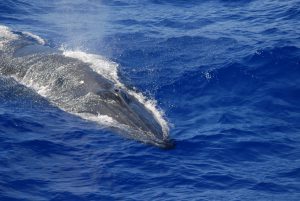
The large head and double blowhole of a Bryde’s whale.
Photo: NOAA
Another toothed whale reported is the Orca, or killer whale. These are rare and are most often spotted in the central portion of the Gulf. There are numerous beaked whales and dolphins, but – though reported in early whaling logs – recent surveys suggest there are no porpoise. Porpoise differ from dolphin both in size and tooth shape. The most abundant dolphin is the pantropical spotted dolphin. Those who lived in the area in the 1980s and early 1990s might remember a stranding of dolphins that involved an adult female “Mango” and small baby named “Kiwi”. Mango died during recovery, but Kiwi lived for many years at the Gulfarium in Ft. Walton – these were pantropical spotted dolphins. The most familiar, and most often seen, are the Atlantic Bottlenose dolphins. These are a coastal species, many pods living within the estuary itself. They are the stars of many aquarium shows.
As you might guess, toothed whales are all carnivores. They only have canine teeth, so they must swallow their food whole. Their favorites are fish and squid. They have an amazing sense of echolocation that can help them navigate waters, detect prey, and even “stun” prey making it easier to eat. They give live birth as we do, and the calves stay with their mom for about two years learning how to survive. Cetaceans are very social forming groups known as pods. Most pods are dominated by females and young. Only one or two males are present.
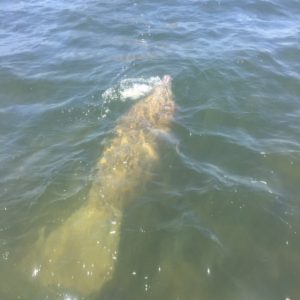
A lone manatee spotted in Big Lagoon near Pensacola Pass. Sightings like these are becoming more common.
Photo: Marsha Stanton
Manatees are members of a group called Sirenia. This name comes from the fact that Columbus’ crew thought they were mermaids – “sirens of the sea”. It has been said before, that if they thought manatees were mermaids – their idea of a mermaid, and ours, is very different. That said, that is where they get their name. There are four species of sirenians on our planet, the one found here is the West Indian Manatee. They are found through the Caribbean, South Atlantic, and Gulf of Mexico. It is believed now that there are two subspecies – the Antillean of the Caribbean, and the Florida manatee from our neck of the woods. These are slow moving herbivores who can tolerate freshwater. They have a low tolerance for cold water and seek warm water springs, and the warm water discharges from power plants, during the winter.
Manatees are not as social as cetaceans and are usually not found in large groups unless they gather in warm water spots. Females usually give birth to a single calf which stays with her for about two years. They have flat molars, like cows, and feed on a variety of plants – the source of their other common name… “sea cows”. The numbers of these animals have increased in recent decades, but they are still low, and the animal is still protected. Boat strikes is one of the leading causes of death, though red tide, and cold stunning are also problems. Sightings of these animals in our area are increasing and we are currently tracking encounters at the county extension office. If you see one, please contact Rick O’Connor at the Escambia County Extension Office – (850) 475-5230, or roc1@ufl.edu.

Though the days of “Save the Whales” and “Save the Manatee” are not as common, these animals still face low numbers and problematic encounters with humans. Fishing gear, boat strikes, sounds, all take marine mammals in the Gulf each year. Hopefully we all get to check off seeing one of these magnificent creatures from our bucket list before the end of our time.
Resource:
Wursig, B. 2017. Marine Mammals of the Gulf of Mexico. In: Wards, C. (ed.) Habitats and Biota of the Gulf of Mexico: Before Deepwater Horizon Oil Spill. Springer, New NY.
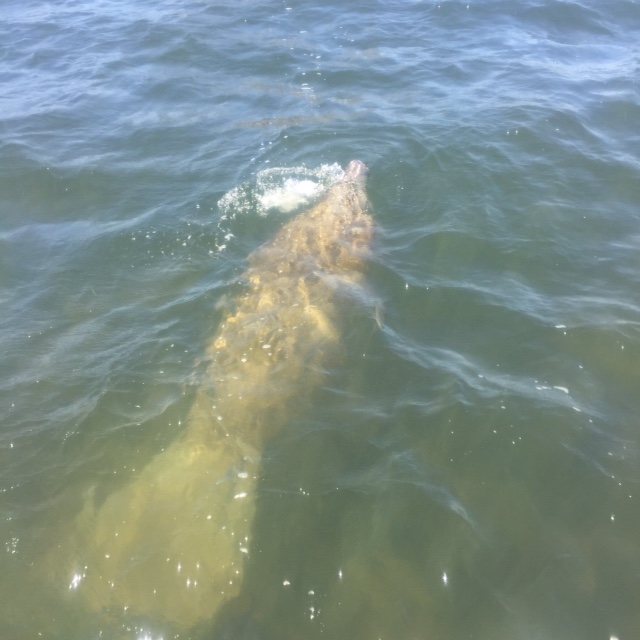
by Rick O'Connor | Jun 7, 2019
This is becoming an annual summer encounter – manatees in (near) the Intracoastal Waterway of Pensacola Bay area. They have been before, it is not uncommon for them to be seen at Palafox Pier Marina, but in the last few years groups of five to nine manatees have been spotted drifting along the shorelines and hanging around docks in Gulf Breeze and the Perdido Key area.

Manatee swimming in Big Lagoon near Pensacola.
Photo: Marsha Stanton
I cannot say what this means but we are not alone with these new visitors along the Gulf coast. There are enough manatee sightings in the lower portions of Mobile Bay that manatee signs have been placed along Magnolia River and a manatee watch hotline has been set up at Dauphin Island Sea Lab. There are at least 40 resident manatees in the Wakulla River. And now, at least in the last two years, small groups have been seen in our area. Concerned whether these manatees were returning to southwest Florida for the winter during the red tide, there were plans to tag some of them – I am not sure if that was done or not.
So, what does this mean for us?
Well, your first thought is the concern over boat strikes. The manatee has actually been protected by Florida law since 1893. Their numbers have increased to 6600 animals and so their status has been changed from endangered to threatened. That said, they are still protected by both the Endangered Species Act and the Marine Mammal Protection Act.
According to an FWC report, in 2018, 824 manatees died in Florida. The top five causes were (1) Natural causes – 27%, (2) Undetermined – 20%, (3) Watercraft – 15%, (4) Perinatal death – 14%, and (5) Unrecovered – 13%.
There were 17 deaths reported from the Florida panhandle. Wakulla (7), Franklin and Escambia (3), Bay, Gulf, Okaloosa, and Walton (1).
Cold stress was the #1 cause of death (7) – Bay, Escambia, Franklin, Okaloosa, and Walton
Followed by boat strikes (4) – Wakulla (2), Escambia (2)
Unrecovered (3) – Franklin, Gulf, and Wakulla
Undetermined (2) – Wakulla
Perinatal (1) – Wakulla
Natural (1) – Wakulla
So far, in 2019 there have been 259 manatee fatalities. The top five causes were (1) Watercraft – 25%, (2) Undetermined – 24%, (3) Cold stress – 15%, (4) Unrecovered – 13%, and (5) Natural – 13%
In the Florida panhandle there have been four deaths so far. Bay County has had two due to cold stress and Wakulla has had two – one was unrecovered and the other was “other” but human related.
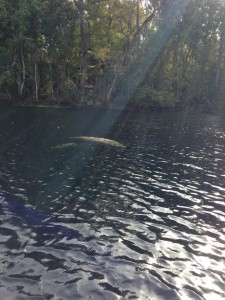
Manatees hanging out in Wakulla Springs.
Photo provided by Scott Jackson
So, statewide watercraft are still a big concern. Two of the three deaths in Escambia were boat related. The manatees tend to stay out of the boat channels, so it is recommend boaters remain in the navigable channels while heading to a destination and, when leaving the channel to reach that destination, go idle speed and have a lookout.
Manatees have actually benefitted the management of invasive hydrilla in the Wakulla River. FWC no longer has to treat it – the manatees are eating it all. Pensacola Bay is currently experiencing a bloom of epiphytic (attached) drift algae on the seagrass beds. Maybe, just maybe, the few manatees we see will consume as much algae they can.
I can understand the concern some boaters may have with manatees in the area. However, they do provide some benefits and are the highlight of the day for any local or visitor who may see them. We should welcome them and do what we can, within the law, to keep them safe. If you spot a manatee, please report it to the Dauphin Island Sea Lab hotline: 1-866-493-5803. Or email manatee@disl.org.

by Rick O'Connor | Jul 6, 2018
The manatee may be one of the more iconic animals in the state of Florida. In Wyoming, we think of bison and bears. In Florida, we think of alligators and manatees. However, encountering this marine mammal in the Florida panhandle is a relatively rare occurrence… until recently.

Manatee swimming in Big Lagoon near Pensacola.
Photo: Marsha Stanton
For several years now, visitors to Wakulla Springs – in the eastern panhandle – have had the pleasure of viewing manatees on a regular basis. It is believed about 40 individuals frequent the river. Last year there were eight individuals that frequent the Perdido Key area, and a couple more were seen more than once near Gulf Breeze. This is not normal for us, but already this year one manatee has been spotted in the Big Lagoon area – so we may be seeing more as the summer goes on.
So what exactly is a manatee?
It is listed as a marine mammal, but frequents both fresh and saltwater habitats. Being mammals, they are warm blooded (endothermic). Maintaining your body temperature internally allows you to live in a variety of cold temperature habitats but water can really draw the heat quickly from anyone’s body. Marine mammals counter this problem by having a thick layer of fat within the skin – insulation called blubber. However, the manatees blubber layer is not very thick. So they are restricted to the tropical parts of the world and, in Florida, spend the winter near warm water springs. Many have learned the trick of hanging out near warm water discharges near power plants. In the warmer months, they venture out to find lush seagrass meadows in which to graze.
They are herbivores. Possessing flat-ridged molars for grinding plant material, they are more closely related to deer and cattle than the seal and walrus they look like. They lack canines and incisors, which deer and cattle use to cut the grass blades, but have large extending lips that grab and tear grasses with – very similar to the trunk of an elephant, which is their closest relative. Like many mammalian herbivores, they grow to a large size. Manatees can reach 15 feet in length and over 1000 pounds. They have two forearms that are paddle shaped and used for steering. The tail is a large circular disk called a fluke, which propels them through the water and is often seen breaking the surface. They are generally slow moving animals but can startle you when they decide to kick into “fourth gear” and burst across the river.
They are generally solitary animals, gathering in the wintertime around the warm springs. Males usually leave the females after breeding and do not form family units, or herds. Females are pregnant for 13 months and typically give birth to one calf, which stays with mom for two years. Like all mammals, the young feed on milk from mammary glands, but these glands are close to the armpits on the manatee. This makes it much easier for the calf to feed while both are swimming. This is not the case with dolphins and whales, where the mother must roll sideways to feed her young.

Manatees hanging out in Wakulla Springs.
Photo provided by Scott Jackson
There are three species of manatees in the world today. The Amazonian Manatee (Trichechus inunguis), the West African Manatee (Trichechus senegalensis) and the West Indie Manatee (Trichechus manatus). The Florida Manatee is a subspecies of the West Indian (Trichechus manatus latirostris). In the 1970’s it was estimated there were about 1000 West Indian manatees left in the word. Today, with the help of numerous nonprofits and state agencies, there is an estimated 6600 in Florida. Due to this increase, the manatee has moved from the federal endangered species list to threatened species. That said, human caused mortality still occurs and boaters should be aware of their presence. Since 2012, an average of 500 manatees die in Florida waters. Most of these are prenatal or undetermined, but about 20% are from boat strikes. Manatees tend stay out of the deeper channels, so boats leaving the ICW for a favorite beach or their dock should keep an eye out. Most of the time they are just below the surface and only their nostrils break for a breath of air. They usually breathe every 3-5 minutes when swimming but can remain below for up to 20 minutes when they are resting. Approaching a manatee is still illegal. Though their status has changed from endangered to threatened, they are still protected by state and federal law.
FWC suggest the following practices for boaters, and PWC, near manatees
- Abide by any speed limit signs – no wake zones
- Wear polarized sunglasses to aid in seeing through the water
- Stay in deeper water and channels as much as possible
- Stay out of seagrass beds – there is are numerous reasons why this is important, not just manatees
- If a manatee is seen, keep your boat/PWC at least 50 feet from the animal.
- Please do not discard your hooks and monofilament into the water – again, numerous reasons why this is a bad practice.
So Why are There More Encounters in the Florida Panhandle?
Good question…
Their original range included the entire northern Gulf coast. When their numbers declined in the 1960’s and 70’s there were fewer animals to venture this far north. Manatee sightings at that time did occur, but were very rare. Today, with increasing numbers, encounters are becoming more common. There is actually a Manatee Watch Program for the Mobile Bay area (https://manatee.disl.org/) and they have been seen as far west as Louisiana.
They are truly neat animals and to see one in our area is a real treat. Remember to view and photo, but do not approach. I hope that many of you will get to meet what maybe new summer neighbors.
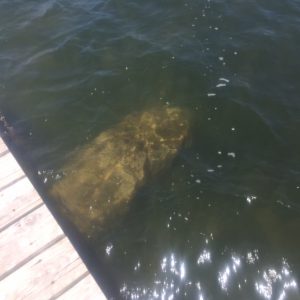
Manatee swimming by a pier near Pensacola.
Photo: Marsha Stanton
References
2017 Manatee Mortality Data. Florida Fish and Wildlife Conservation Commission. http://myfwc.com/media/4132460/preliminary.pdf.
Florida Manatee Facts and Information. Florida Fish and Wildlife Conservation Commission. http://myfwc.com/education/wildlife/manatee/facts-and-information/.
Manatee Information for Boaters and PWC. Florida Fish and Wildlife Conservation Commission. http://myfwc.com/education/wildlife/manatee/for-boaters/.
Manatee Sighting Network. https://manatee.disl.org/.
West Indian Manatee. Wikipedia. https://en.wikipedia.org/wiki/West_Indian_manatee.

by Rick O'Connor | Feb 16, 2018
As a young boy growing up here in the panhandle, I had heard of this thing called a manatee – but had never seen one. They came more into the light when I was a teenager and becoming interested in marine biology. I was the president of the high school marine biology club and one of our goals was to raise money for a trip to Crystal River to snorkel with them. The Save the Manatee Club originated in that time trying to bring more awareness to the plight of this endangered Floridian and at one point, Jimmy Buffett had led the way.
I had learned a lot about them, found out their original range was from North Carolina south to the Caribbean and the entire Gulf of Mexico, but were now down to about 1000 animals and those were found in Florida. Eventually I did get to see manatees, and have snorkeled with them many times, but still thought of them as a south Florida animal – rarely found in the panhandle.

Manatee swimming in Big Lagoon near Pensacola.
Photo: Marsha Stanton
Then the recent news report – two dead manatees in the last two weeks. One washed ashore in Okaloosa county and the other in Escambia. Probably victims of the recent cold fronts. It is not unheard of finding manatees in the panhandle in recent years. I recall since the 1990’s a manatee seen in Bayou Texar in Pensacola. In another year, one was seen near Ft. Pickens. My son worked at a local marina and saw at least one a year there. There have been so many seen in the Mobile Bay area that Dauphin Island Sea Lab now has a Manatee Watch program. There are about 40 individuals that now visit Wakulla Springs. In addition, this summer there were two separate groups living in the Pensacola area. One group was residing near Gulf Breeze and a second group of about eight animals was frequently seen near Perdido Key. These once rare animals in the panhandle are now being found each year, and sometimes in groups.
What is going on?
Why are manatees beginning to visit our area?
Your first hunch would be climate change. Manatees are marine mammals but unlike their dolphin cousins their blubber layer is not as thick and they must seek warm water refuge during the winter months. When water temperatures drop below 67°F, they locate the warm water springs found in central Florida – or move south Florida where the water remains comfortable year round. If they are remaining here, could the average water temperatures have warmed enough for them to make this move?
Along this same line, mangroves are now being found in the panhandle. Both red and black mangroves have been found growing in local estuaries. In the Apalachicola area there have been quite a few located. In the western panhandle there a few individuals here and there. Further west they are found on the islands of Mississippi and have been in the Chandeleurs for many years now. Later this spring Florida Sea Grant will be conducting surveys in each county to see where these tropical trees may be growing.
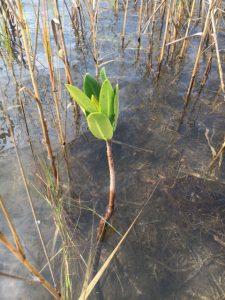
A small red mangrove growing in Big Lagoon near Pensacola FL
Photo: Rick O’Connor
And most recently are sightings of snook, a south Florida fish that have, though rare, been seen in the northern Gulf of Mexico. No doubt this Januarys hard freezes probably killed the mangroves that were here, and probably the two manatees washed ashore recently, but it will be an interesting time to see what other tropical species begin their slow migration northward. If it does happen, what will that mean? How will these changes impact local ecosystems? At this point, I am not sure if it will happen or, if it does, how fast – but it will be interesting.
by Scott Jackson | Nov 29, 2013
Check into the lodge at Wakulla Springs State park on a crisp cool evening and you are immediately greeted with the warmth of an open hearth fireplace and the security of stone walls radiating comfort and solace. These stately accommodations meet all your needs for refuge and rejuvenation with opportunities for an old fashion game of chess or checkers, great food, and time to reconnect with cherished friends and family.

Wakulla Springs Lodge offers guests warmth and rest from the winter’s cooler weather just like the springs offers manatees refuge on winter’s coldest days. (Photos by L. Scott Jackson)
Wakulla Springs hosts about 200,000 visitors each year and is one of North Florida’s most popular swimming spots with peak attendance between April and August. It’s a great place to beat the heat on a hot summer’s day. The same cool 250 million gallons of 69F degree water that provides welcome relief to visitors on hot summer’s day also provides an inviting warm refuge on winter’s coldest days to another type of park guest, manatees.
Wakulla Springs is the Gulf of Mexico’s northernmost geographic location where manatees congregate and consistently overwinter in large numbers. Last week, park guides estimated 30 individuals in the springs and river run.
Florida Fish and Wildlife Conservation and Commission / Florida Wildlife Research Institute’s winter synoptic aerial survey of Florida’s manatees in 2011 totaled 4,834 individuals. Improved survey techniques have resulted in increased estimates for Florida manatees in recent years, however, they still remain listed as endangered.
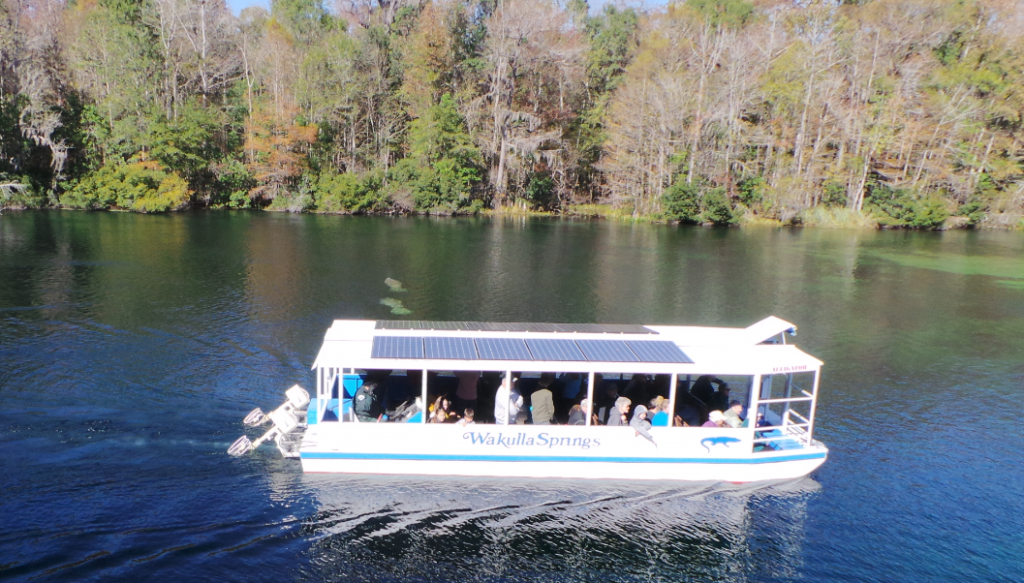
Daily river cruises on the Wakulla River are a great way to see manatees and other unique wildlife. (Photo by L. Scott Jackson)
Consistent water temperatures below 65F can result in stress, pneumonia, or colds in manatees. Other environmental conditions can also cause problems for manatees. This year, a large number of Florida manatee moralities have been reported as a result of a harmful algal bloom on the Atlantic Coast in the Indian River Lagoon. Florida manatees are also frequently struck by boat hulls and boat motor propellers; the signs of which are often seen in individuals with tell-tale propeller scars.
[youtube=http://www.youtube.com/watch?v=0D2tNXrQ5CI]
Education and stewardship are two of the best ways to help manatees. You can connect with these Florida ambassadors locally on a Wakulla Riverboat Tour at the State Park or through outfitters that provide kayaks and local guiding knowledge. Simple changes in home practices that protect water quality also protect the water resources used by manatees and other wildlife. Observing manatee protection zones and reducing boat speed also have been shown to reduce the impact of boating activities on manatees. To report sick or dead manatees, please call the FWC Wildlife Alert Hotline at 888-404-FWCC (3922).
Read more manatee facts in the following UF/IFAS publication: Life in the Sea.
